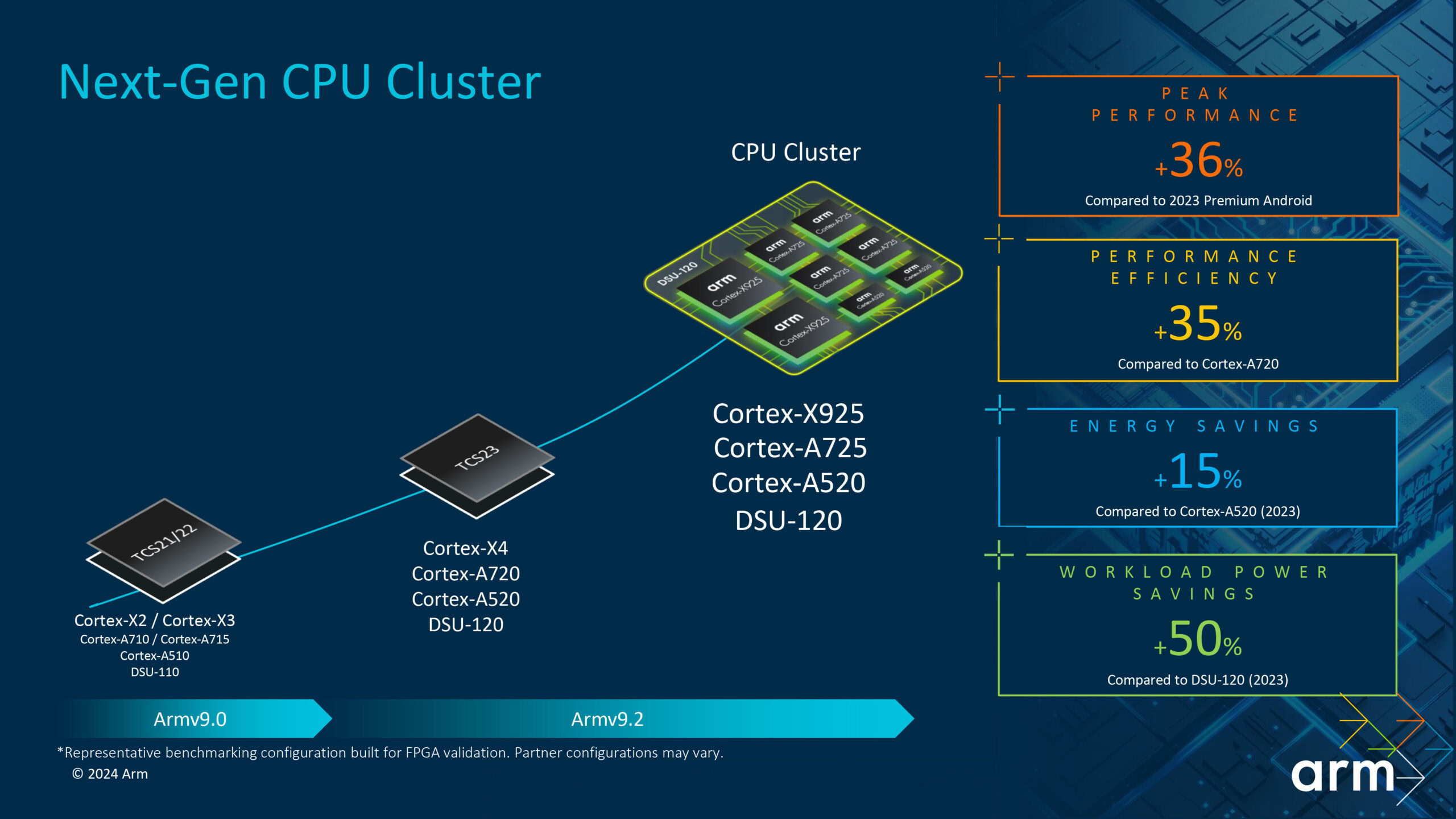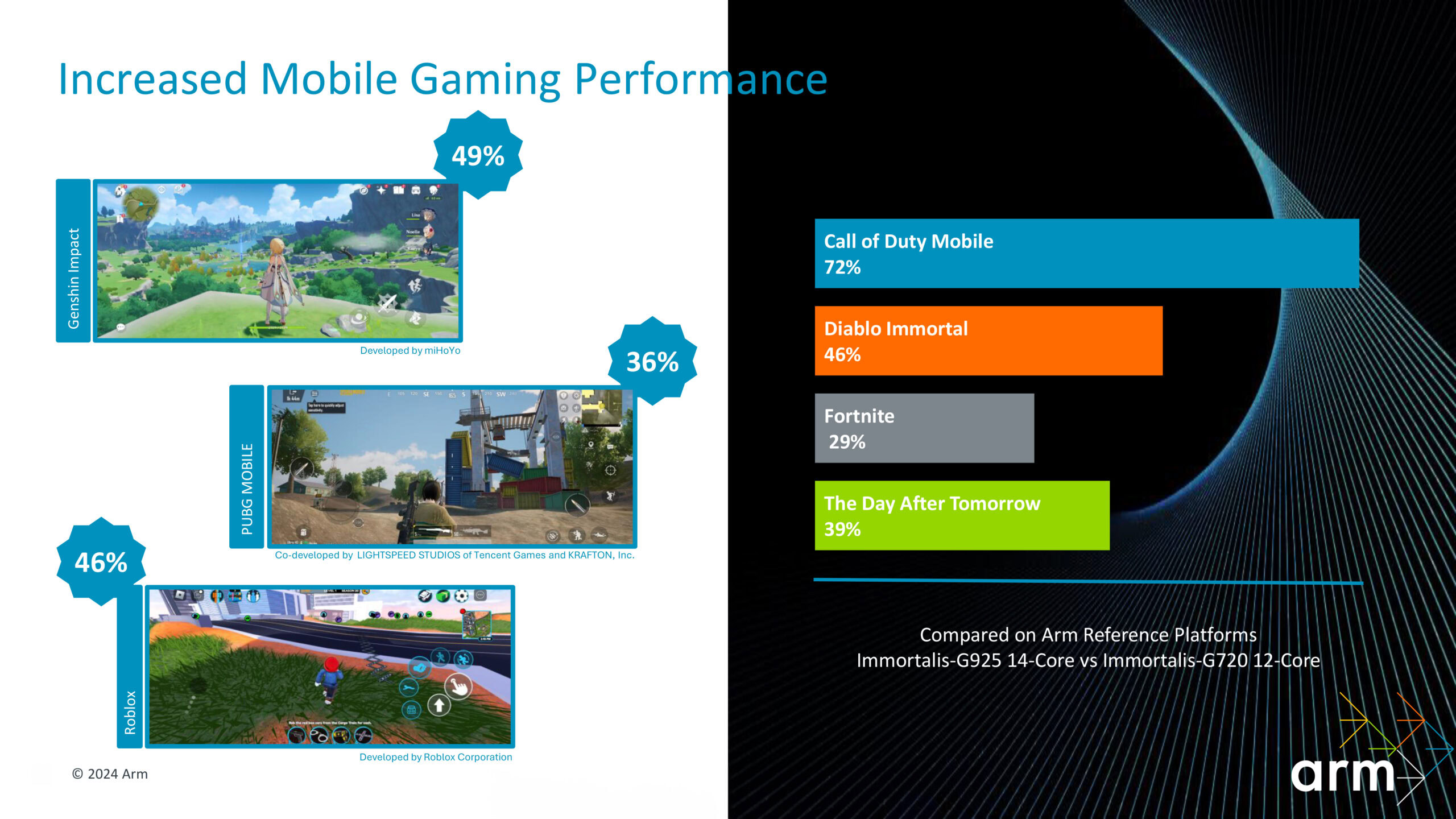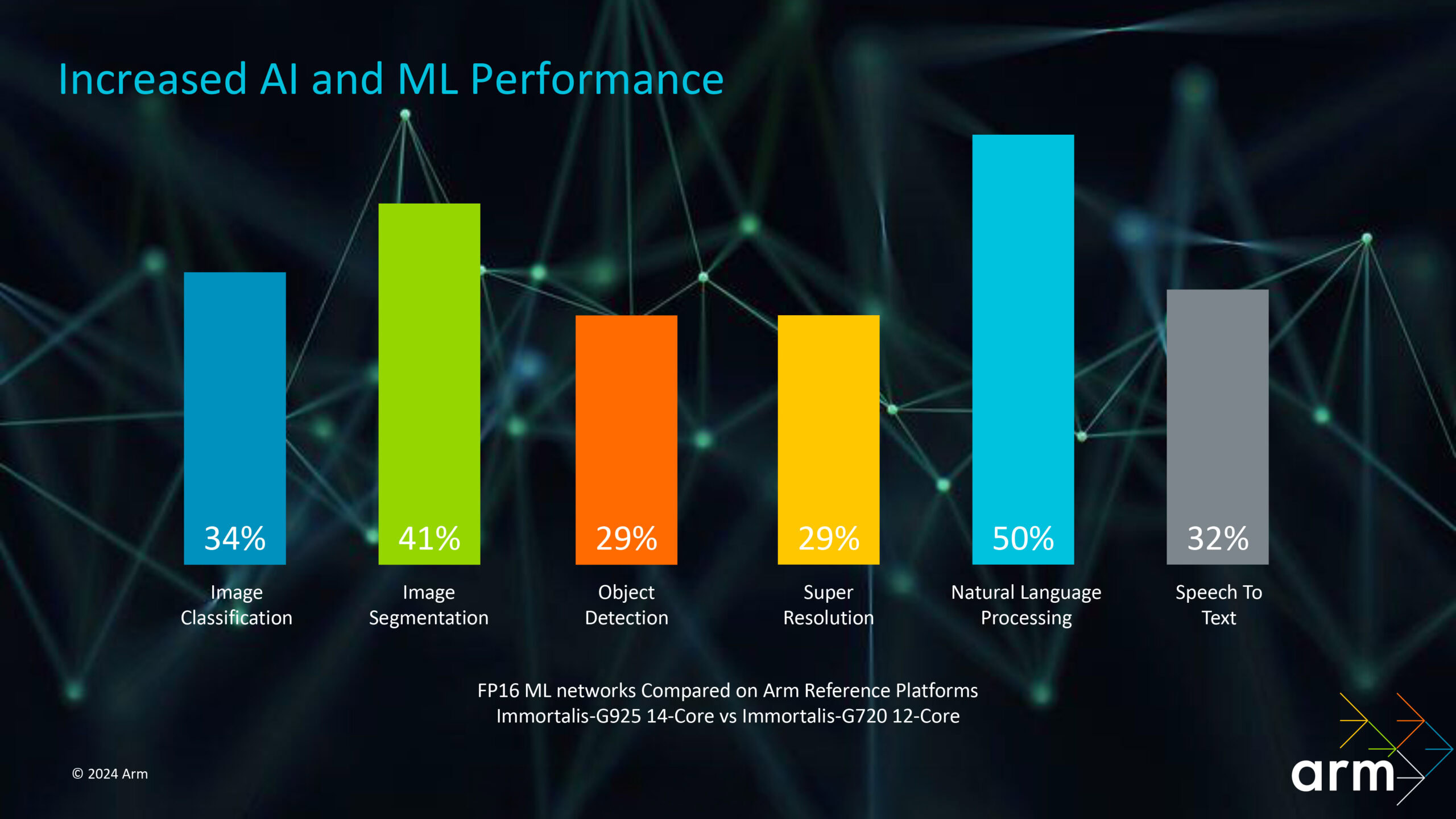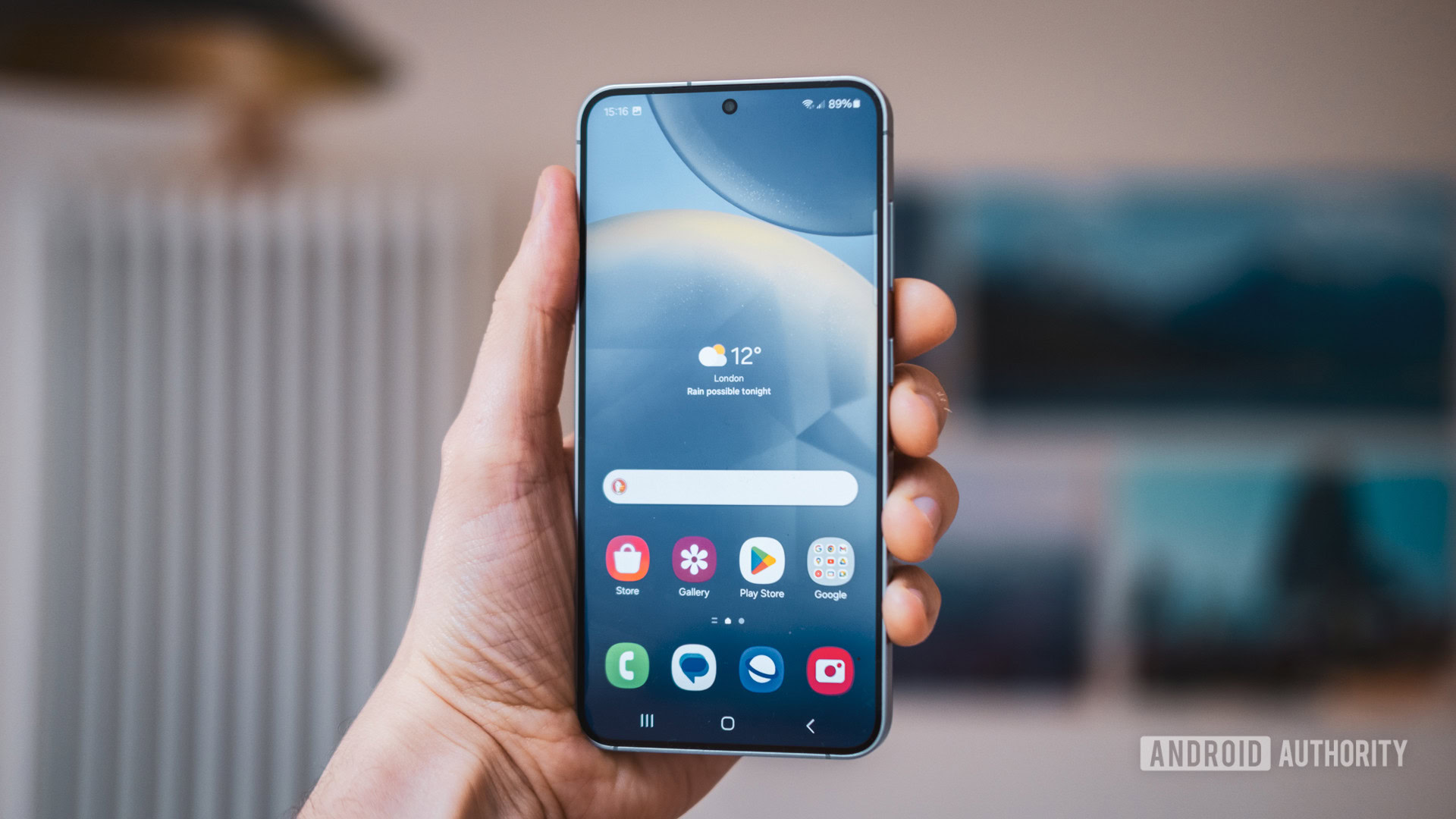Contents
The giant one: Arm Cortex-X925 core
| Cortex-X925 | Arm Cortex-X4 | Arm Cortex-X3 | Arm Cortex-X2 | |
|---|---|---|---|---|
| Peak clock velocity | Cortex-X925~3.6GHz | Arm Cortex-X4 ~3.4GHz | Arm Cortex-X3 ~3.25GHz | Arm Cortex-X2 ~3.0GHz |
Decode Width | Cortex-X925 10 directions | Arm Cortex-X4 10 directions | Arm Cortex-X3 6 directions | Arm Cortex-X2 5 directions |
Dispatch Pipeline Depth | Cortex-X925 10 cycles | Arm Cortex-X4 10 cycles | Arm Cortex-X3 11 cycles for directions | Arm Cortex-X2 10 cycles |
OoO Execution Window | Cortex-X925 1,500 | Arm Cortex-X4 768 | Arm Cortex-X3 640 | Arm Cortex-X2 448 |
Execution Units | Cortex-X925 (assumed) 6x ALU (some 2-cycle) 2x ALU/MAC 2x ALU/MAC/DIV 3x Branch | Arm Cortex-X4 6x ALU 1x ALU/MAC 1x ALU/MAC/DIV 3x Branch | Arm Cortex-X3 4x ALU 1x ALU/MUL 1x ALU/MAC/DIV 2x Branch | Arm Cortex-X2 2x ALU 1x ALU/MAC 1x ALU/MAC/DIV 2x Branch |
Architecture | Cortex-X925 ARMv9.2 | Arm Cortex-X4 ARMv9.2 | Arm Cortex-X3 ARMv9 | Arm Cortex-X2 ARMv9 |
The good points from 3nm are crucial a part of the efficiency uplift anticipated for this era. Arm has labored widely to optimize its design for its companions on each FinFET and GAA processes (aka TSMC and Samsung). That leaves the 15% like-for-like development over the former style, which comes all the way down to a number of key adjustments within the X925’s microarchitecture.
In the processing core, for instance, the X925 now has six SIMD devices (the robust quantity crunchers that batch compute floating level math and AI workloads) up from 4, permitting them to do extra heavy math in parallel. This most probably accounts for lots of the core’s AI/ML efficiency spice up. There’s additionally an extra integer multiply unit and further floating level evaluate unit, which once more will increase the core’s sheer number-crunching features when totally fed. Arm is reluctant to talk about die space measurement in this day and age, however the X925 will have to be getting beautiful giant.

Robert Triggs / Android Authority
Another fascinating alternate is that one of the ALUs were switched to devoted 2-cycle instruction variations. This is helping keep away from stalls within the common 1-cycle devices however possibly implies that those ALUs can’t carry out one of the more practical mathematics. This turns out like one of these design alternate that handiest intricate use-case knowledge would allude to.
Instruction dispatch stays 10-wide, however Arm has doubled the X925’s most selection of directions in flight, now a colossal 1,500. Likewise, there’s two times the L1 instruction cache bandwidth and double the L1 instruction search for desk measurement to hurry up instruction fetching. Meanwhile, the backend is composed of an additional load pipeline to convey extra knowledge in from reminiscence. In different phrases, there are many out-of-order directions floating round to stay the ones number-crunching cores busy.
That’s a large number of jargon, however the issues are very acquainted from earlier years— an ever-wider entrance finish feeding an an increasing number of insatiable execution engine. In that sense, the X925 is an replace to the X4 quite than a wholesale redesign. Even so, efficiency will take a forged jump ahead once more in 2025, despite the fact that a good chew of the advantages additionally come from the transfer to 3nm.
Power-efficient Arm Cortex-A725 and A520
Sadly, Arm hasn’t supplied as many information about the similarly essential Cortex-A725 — the brand new heart core that’ll shape the spine of upcoming cell SoCs.
Arm claims that the A725 is 25% extra effective than the A720 and gives the choice for upper height efficiency if required. Again, despite the fact that, this means the transfer to 3nm, and Arm hasn’t given us a regular metric for IPC efficiency good points. However, it claims a 20% spice up to L3 visitors, which is helping notice some additional efficiency.
On the microarchitecture degree, Arm larger the re-order buffer and instruction factor queue sizes, making improvements to throughput. A brand new 1MB L2 cache configuration additionally permits the core to succeed in the next efficiency degree. But if that’s it, the A725 is a minor revision of the A720, which was once already an optimization of 2022’s A710 core.

Robert Triggs / Android Authority
This leads us to the refreshed Cortex-A520, surely the least thrilling style on this 12 months’s CPU trio. The core structure stays unchanged. Instead, Arm has optimized the A520 footprint for upcoming 3nm processes, leading to 15% energy-efficient good points.
Looking at Arm’s chronic potency curves, this era has a good larger crossover between the Cortex-A725 and A520. While the A520 can nonetheless succeed in the very lowest chronic ranges for standby and low-clock duties, the A725 can ship hugely extra efficiency for a similar chronic as a maxed-out A520. In different phrases, many duties run a lot quicker and simply as successfully at the A725. It’s little marvel that Arm’s 2024 reference design suggests simply two A520s, additional lowering the selection of small cores from what we see in current-generation chipsets.
Vastly advanced gaming with the Immortalis G925
Arm continues to improve its GPU line-up too, with the Immortalis G925, Mali G725, and Mali G625. As with final 12 months’s vary, silicon companions want to use a bigger core rely to verify powerful ray tracing efficiency and leverage the Immortalis branding. Ten to 24 cores, up from 16 final gen, is assessed as Immortalis, six to 9 for a G725 implementation, and one to 5 cores for the cheap G625 setup.
Regardless of the configuration, every G925 core guarantees a 30% aid in chronic intake when constructed on 3nm, as much as 37% advanced efficiency, and a whopping 52% achieve in ray racing over last-gen’s Immortalis G720. That final metric has a large caveat: it calls for builders to leverage new APIs to designate goals as “intricate gadgets,” which the G925 then strains with lowered constancy. Think leaves or grass this is very dear to compute personally however that avid gamers received’t realize if ray traced at decrease accuracy. It’s a neat thought, however completely depending on builders understanding about after which coding for.

In real-world video games, Arm is claiming much more vital good points with 14 Immortalis G925 cores as opposed to 12 older G720. Of route, that’s now not a like-for-like comparability, so take it with a pinch of salt. But giving Arm the advantage of the doubt, I’d bet that you’ll are compatible 14 G925 cores within the house of 12 of the former G720s, however that’s completely my hypothesis.
Still, for simply two extra cores, Arm touts a 72% efficiency development in Call of Duty, 49% in Genshin Impact, 46% in Diablo Immortal, and a 29% achieve in Fortnite. The key likes within the core’s new Fragment Prepass method. The TLDR is this hugely improves hidden object culling (suppose a participant or object hidden in the back of a wall), lowering CPU load for those giant efficiency good points. Games with advanced geometry get advantages maximum, therefore the efficiency variations between CoD and Fortnite.
If you need a better rationalization, Arm has changed the normal Z-buffer Hidden Surface Removal (HSR) method, like ahead pixel kill or primitive re-ordering, with its fragment prepass generation. The key distinction is that it eliminates the want to re-order the Z-buffer (intensity buffer) to make culling selections, lowering motive force CPU cycles through as much as 43% in line with thread. This is all executed in {hardware}, that means there’s no overhead for builders, however it doesn’t get advantages all video games similarly.
What about AI?

No 2024 announcement is whole with out AI, and Arm had a good bit to mention right here in spite of now not having a devoted AI accelerator to reinforce its extra conventional CPU and GPU portions. Instead, Arm is banking at the extra developer-friendly and common enchantment of the CPU and, to a lesser extent, the GPU to tout its AI features.
For example, Arm issues out that the majority third-party AI Android apps run at the CPU quite than an accelerator, as few have invested the advance sources to make stronger the a large number of SoC API platforms. In lieu of a extra common API, Arm is banking at the CPU to stay a vital part for AI. That stated, that is a lot more uncomplicated to mention whilst you don’t have pores and skin within the cell AI accelerator marketplace.
Still, Arm has some efficiency numbers to trot out right here. The Arm Cortex-X925 boasts a 42% quicker time to first token with an 8-billion LLaMA 3 style and 46% quicker for a three.8 billion Phi 3 style. AI CPU inference may be up 59% in comparison to the Cortex-X4, with GPU inference features receiving a 36% spice up over final 12 months’s reference platform. Similarly, the brand new GPU (in a 14-core as opposed to 12-core configuration) is as much as 50% quicker in herbal language processing, 41% quicker in symbol segmentation, and 32% quicker for speech-to-text.
Those are all very welcome enhancements to assist in making AI apps extra responsive, however it’s value remembering that neither a CPU nor a GPU is as rapid and effective as a devoted AI accelerator.
What to be expecting from next-gen merchandise

Robert Triggs / Android Authority
Arm’s next-gen cores are destined for 2025 flagship smartphones, with Samsung and MediaTek prone to be the most important cell silicon distributors to leverage those state-of-the-art applied sciences. Qualcomm is shifting to a brand new customized CPU core for the Snapdragon 8 Gen 4, which means that that almost all of flagship Android telephones in 2025 more than likely received’t use Arm Cortex-X925 or Immortalis-G925.
Likewise, the impending main wave of Windows on Arm laptops are all powered through Qualcomm’s Snapdragon X Elite platform. Again, this platform makes use of customized CPU cores quite than Arm’s Cortex. Arm didn’t have a lot to mention about particular plans for Arm-based PCs, most probably given Qualcomm’s exclusivity take care of Microsoft, which is rumored to finish in 2024. Still, it’s completely imaginable that we’d see different silicon distributors use Arm Cortex-X cores, reasonably most likely the brand new X925, for rival chipsets someday in 2025. For example, Arm envisions a PC chip with as much as 12 Cortex-X925 CPU cores to push efficiency well past cell.
Although Arm introduced its newest consumer applied sciences within the first part of the 12 months, spouse chipsets will likely be introduced close to the tip of 2024, on the earliest. Smartphones powered through the Cortex-X925 and/or Immortalis-G925 are anticipated to land in shopper palms in early 2025.
Source: www.androidauthority.com



